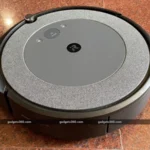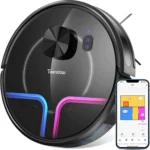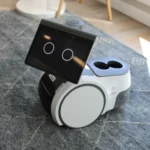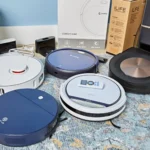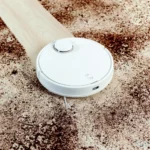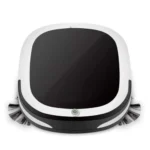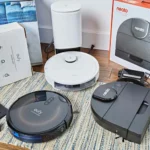As the technology evolves, we are introduced to new and exciting ways to simplify our daily routines. One of the most intriguing advancements in home cleaning is the integration of smart mapping technology in robot vacuum cleaners.
Smart mapping technology is an innovative feature that allows robot vacuum cleaners to map and memorize the layout of your home, making it easier for them to navigate and clean efficiently. In this article, we will explore the advantages of using smart mapping technology in robot vacuum cleaners and how it can enhance your cleaning experience. Let’s take a closer look.
What is Smart Mapping Technology

Smart Mapping Technology is a recent innovation that has revolutionized the way robot vacuum cleaners clean homes. It offers a simple, efficient, and intuitive way of cleaning every inch of your home, including hard-to-reach areas, under furniture, and tight corners. The technology utilizes a series of sensors and onboard memory to map your home, efficiently clean, and systematically navigate back to its charging dock. With the ability to customize cleaning schedules, voice command, and app integration, smart mapping technology has become an indispensable tool for modern-day households. In the following sections, we’ll dive into the mechanics of this technology and explore its numerous advantages. But, before that let’s take a look at some of the top reasons why robot vacuums are becoming increasingly popular.
1.1 Mapping
One of the notable features of Smart Mapping Technology in robot vacuum cleaners is the mapping capability. The robots equipped with this technology use sensors to create a digital blueprint of the living space’s layout. This map serves as a guide for the robot vacuum to navigate and clean the house more efficiently. The robot can easily move around the furniture, climb up the staircases, and avoid obstacles using the map.
The mapping function of a robot vacuum cleaner with Smart Mapping Technology ensures that the cleaning coverage is maximized. It allows the robot vacuum to cover every corner of the house without repeatedly going over the same area. The robot vacuum can create a map of multiple levels of the house, making it easier for the robot to clean and navigate through different floor levels. It also enables the robot vacuum to remember the cleaning progress and continue where it left off if it gets interrupted by low battery or recharging.
With the mapping function of Smart Mapping Technology, users can also specify the areas that the robot vacuum should clean. If there are certain places in the house that require more cleaning than others, the map can be adjusted to direct the robot vacuum to clean those specific areas. This feature maximizes the cleaning efficiency of the robot vacuums and saves time for the users.
Using Smart Mapping Technology, robot vacuum cleaners can produce more accurate cleaning maps compared to conventional robotic vacuums that do not have this technology. This is because Smart Mapping Technology has advanced sensors that detect and create a highly detailed map of the living space’s layout. As a result, the robot vacuum can clean the entire house without missing a single spot.
The mapping technology of robot vacuum cleaners with Smart Mapping Technology is an alternative to traditional vacuum technology that requires manual operation like upright vacuums or canister vacuums. In contrast, robot vacuums with Smart Mapping Technology can create an efficient cleaning map autonomously without human intervention.
Compared to its traditional counterparts, robot vacuum cleaners with Smart Mapping Technology are quieter and emit less noise pollution, thanks to the mapping capability that allows them to avoid bumping into walls and other obstacles. Additionally, robot vacuum cleaners with Smart Mapping Technology are more energy-efficient, which translates into lower electricity bills.
To read more about the advantages of using Smart Mapping Technology in robot vacuum cleaners, check out our top reasons why robot vacuums are worth it.
1.2 Memory
Smart Mapping Technology in robot vacuums also includes a feature called Memory, which allows the device to create a mental image of the house layout to ensure that it covers all the areas that need cleaning.
This feature ensures that the robot vacuum does not waste time going over areas that it has already cleaned while ensuring that it does not miss any spots or areas. The Memory feature is essential, especially when the robot vacuum runs low on battery power during the cleaning process. When the battery is running low, the robot vacuum will use its Memory feature to make its way back to the dock for recharging, and once fully charged, it will proceed to continue with the cleaning where it left off.
The Memory feature is also what allows the robot vacuum to learn the layout of the room, memorize the position of obstacles, and gain the ability to sense when an area could benefit from additional cleaning. This is critical when dealing with a room with large furniture or other obstacles. Smart Mapping’s Memory allows the robot vacuum to feel its way around and map out the ideal cleaning path without bumping into any furniture or other items. This means that the robot vacuum will clean around and under any objects in its way without getting stuck.
Memory is an essential feature of Smart Mapping Technology in robot vacuums. It allows the robot vacuum to remember the layout of the house, avoid obstacles, and clean efficiently without wasting time or battery power. With this feature, it is now possible to enjoy a clean home without the hassle of manually cleaning it. If you want to learn more about the benefits of robot vacuums, check out this article about how robot vacuums can improve the cleanliness of your home.
1.3 Multiple Levels Cleaning
Multiple levels cleaning is an important advantage of using smart mapping technology in robot vacuum cleaners. It allows the vacuum cleaner to clean different areas of the house efficiently. With multiple levels cleaning, the robot vacuum cleaner can clean areas of different types, such as carpets, hardwood floors, stairs, and other types of floors.
This feature is made possible through the use of advanced sensors and cameras that help determine the floor plan of the house, allowing the vacuum cleaner to clean each area effectively. The sensors and cameras enable the robot vacuum cleaner to navigate through rooms and move from one level to another. For instance, it can move from the first floor to the second floor without any help.
When using a robot vacuum cleaner that features multiple levels cleaning, the user can specify the areas that need cleaning, helping to save on energy and reduce noise pollution. The robot vacuum cleaner will be able to recognize the different rooms and clean each area according to its specific requirements, such as detecting carpets or hardwood floors.
A vacuum cleaner with multiple level cleaning enables users to specify cleaning schedules for different areas of the house, making it easier to keep their homes clean. This feature is particularly helpful for families with children or pets, who require more frequent cleaning.
Choosing a robot vacuum cleaner with smart mapping technology that features multiple levels cleaning is important because it enhances the vacuum cleaner’s overall cleaning ability. It ensures that the robot vacuum cleaner covers each room effectively, leaving the floors and carpets clean without the need for manual intervention.
Multiple levels cleaning is one of the many advantages of smart mapping technology in robot vacuum cleaners. Robot vacuum cleaners with this feature can clean different areas of the home as they navigate from one room to the other, making it easier for users to maintain a clean environment without manual intervention. With a variety of robot vacuums in the market, it is essential to consider this feature, among other factors when choosing the best robot vacuum cleaner for your home. Check out top reasons why robot vacuums are worth it to get a better understanding of why smart mapping technology is the future of home cleaning.
The Advantages of Smart Mapping Technology
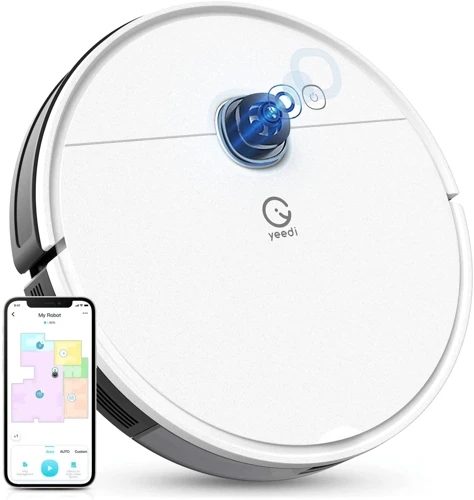
Smart mapping technology is revolutionizing the way we clean our homes. With this cutting-edge technology, robot vacuum cleaners can now navigate our homes with ease and precision, providing a thorough clean without any human interference. The benefits of smart mapping technology are numerous and impressive, and they have the potential to transform our cleaning routines for the better. Let’s take a closer look at some of the advantages that smart mapping technology brings to the table.
2.1 Enhanced Cleaning Efficiency
Using a robot vacuum cleaner with smart mapping technology provides enhanced cleaning efficiency compared to traditional vacuum cleaners. Here are some reasons why:
- Strategic Cleaning Routes: The robot vacuum cleaner uses smart mapping technology to efficiently navigate around the house. It can create maps of the cleaning areas and develop a systematic approach to ensure no spot is missed. This way, the robot vacuum cleaner knows where it has been and where it still has to go, eliminating the need for manual steering, and the risk of human error.
- Spot and Edge Cleaning: Another advantage of using a robot vacuum cleaner is its ability to clean tight spots that are difficult for traditional vacuum cleaners to reach. This machine can easily clean under furniture, along walls, and in tight corners. Additionally, many robot vacuum cleaners come with spot cleaning modes. This feature allows the machine to focus on cleaning a specific, high-traffic area, rather than cleaning the whole house again.
- Multitasking: Robot vacuum cleaners can multitask. While cleaning the floors, they can simultaneously carry out other jobs. For example, some models can mop, and others can empty their dustbin automatically without human intervention. This way, the machine can finish cleaning the home without requiring any manual labor from the owner.
Robot vacuum cleaners with smart mapping technology provide enhanced cleaning efficiency. When choosing between a robot and traditional vacuum cleaner, note that robot vacuums are cost-effective, simplify cleaning, reduce noise pollution and improve air quality. They are the future of home cleaning.
2.2 Avoids Obstacles
Avoiding obstacles is one of the most significant advantages of using a robot vacuum cleaner with smart mapping technology. Unlike traditional robot vacuums that move around aimlessly and bump into objects, smart mapping technology enables the robot vacuum to move around the house smoothly without any collisions.
Robot vacuums include various sensors such as optical sensors, infrared sensors, and laser sensors to detect obstacles and avoid them. These sensors allow the robot vacuum to create a map of the house while vacuuming, and they help the robot vacuum remember where it has already been and where it should go next.
Additionally, the sensors allow the robot vacuum to recognize pets, furniture, and other items on the floor, so it can move around them securely. The robot vacuum will slow down and change its path when it detects an obstacle in its path.
Not only does this technology protect your home and furniture from scratches and damages, but it also prevents the robot vacuum from getting stuck or tangled. The robot vacuum can navigate around cords, shoelaces or any other obstacles on the floor without getting snagged, which could potentially damage the unit.
It’s essential to note that avoiding obstacles also means reducing noise pollution that traditional vacuum cleaner causes. Since the robot vacuum cleaner moves around much more smoothly and quietly, it doesn’t make unnecessary bumps or loud noises. It’s an excellent investment for households with babies or people who work from home.
With the smart mapping technology, the robot vacuum cleaner will carefully clean every corner of your home without requiring any effort or assistance. Thus, it makes life much easier and simplifies cleaning tasks drastically.
By choosing a robot vacuum cleaner with smart mapping technology, you will receive an extra benefit of obstacle avoidance, which increases the robot vacuum’s cleaning efficiency, reduces noise pollution and, most importantly, protects your home and furniture from damage. Robot vacuum cleaner with smart mapping technology can be considered as the future of home cleaning that combines the latest technology in one compact device.
2.3 Time-Saving
One of the biggest advantages of using smart mapping technology in robot vacuum cleaners is its ability to save time. Unlike traditional vacuum cleaners that require manual operation, robot vacuum cleaners are automated and programmed to clean an entire room or house without human intervention.
With smart mapping technology, robot vacuum cleaners are able to scan and map the surface of a room, determining the most efficient cleaning route. By doing so, they can complete their cleaning task much faster than traditional vacuums.
Robot vacuum cleaners can be programmed to clean at specific times, allowing homeowners to schedule cleaning during a time that is most convenient for them. This means that cleaning can be done during off-hours, reducing the amount of time spent on cleaning and freeing up more time for other activities.
The time saved by using robot vacuum cleaners with smart mapping technology is significant and valuable for busy individuals or families. With more time available, they can focus on more important things and enjoy a cleaner home without sacrificing their personal time.
Factors such as battery life, app integration, and price should be taken into consideration when choosing a robot vacuum cleaner with smart mapping technology. However, the time-saving benefits of such technology cannot be overlooked.
If you’re interested in learning more about the costs of robot vacuums compared to traditional vacuum cleaners, check out our article on the topic. Alternatively, take a look at our guide on simplifying cleaning with robot vacuums for more information on the benefits of these devices in general.
2.4 Customizable Cleaning
One of the benefits of Smart Mapping Technology in robot vacuum cleaners is that it allows for customizable cleaning. This means that users have the option to program the robot to focus on certain areas of their home or avoid specific rooms altogether.
For example, if there is a room where valuable items are kept or a room that is frequently used, users can program the robot to clean that area more often. Additionally, if there is an area with lots of cords or furniture with delicate legs, users can program the robot to avoid those areas altogether to prevent any damage.
This customizable cleaning feature can also be helpful for individuals with specific cleaning needs, such as pet owners or those with allergies. By programming the robot to focus on specific areas that require more cleaning, users can ensure that their home is as clean as possible. Additionally, some robot vacuum cleaners offer HEPA filters for improving air quality, making them an ideal option for those with allergies or respiratory issues.
Another advantage of customizable cleaning is that it can help to reduce noise pollution in the home. Users can schedule the robot vacuum cleaner to clean during times when they are not home to avoid any disturbances. Additionally, some robot vacuum cleaners are designed to produce less noise than traditional vacuum cleaners, making them a more peaceful option for those who are sensitive to noise. To learn more about how robot vacuums compare to traditional vacuums, check out our article on robot vacuum cleaners vs. traditional vacuums.
The customizable cleaning feature of robot vacuum cleaners with Smart Mapping Technology is a major advantage. Not only does it allow users to focus on specific areas of their home, but it can also help to reduce noise pollution and improve overall air quality. When choosing a robot vacuum cleaner with Smart Mapping Technology, it’s important to consider factors such as battery life and app integration to ensure that you’re getting the most out of your investment.
2.5 Voice Control Integration
Smart Mapping Technology has brought a revolution in the way robot vacuum cleaners operate. One of the key advantages of Smart Mapping Technology is voice control integration. With voice control integration, users can control robot vacuum cleaners with simple voice commands.
Here are some of the benefits of voice control integration:
- Hands-free operation: with voice controls, you can operate your robot vacuum cleaner without the need for remote control or app control. This makes cleaning more effortless and hassle-free.
- Easy to use: voice control integration makes it easy for people of all ages to operate robot vacuum cleaners. Simple phrases like “start cleaning,” “stop cleaning,” “recharge,” and “return to dock” can be used to control the robot vacuum cleaner.
- Talk to your Robot: Voice commands are a more interactive way of giving instructions to your robot vacuum cleaner. It makes the cleaning process more enjoyable and fun, especially for children.
- Avoid disturbing others: With voice control, you don’t have to worry about disturbing sleeping babies, pets, or your neighbors. You can simply give voice commands in a whisper, and your robot vacuum cleaner will respond accordingly. This is particularly useful for urban dwellers who are keen on reducing noise pollution.
It is important to note that not all robot vacuum cleaners with Smart Mapping Technology have voice control integration. If you prefer voice control, it is essential to choose a robot vacuum cleaner that specifically features it.
Voice control integration is just one of the many advantages of Smart Mapping Technology in robot vacuum cleaners. It makes cleaning more effortless, fun, and convenient. Additionally, it helps to reduce noise pollution caused by vacuum cleaners, making it ideal for urban dwellers. If you want to know more about reducing noise pollution, check out our article on reducing noise pollution with robot vacuums.
Smart Mapping Technology in Action
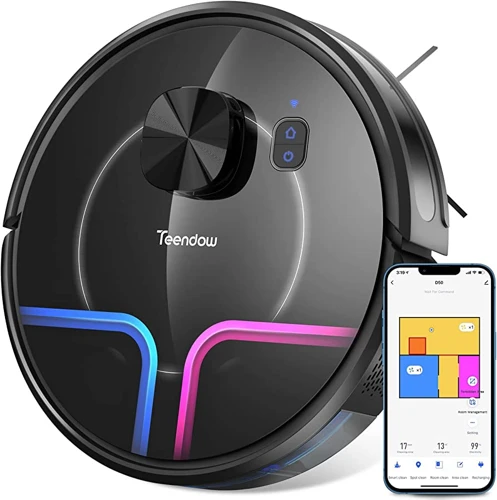
As intriguing as the idea of a robot vacuum cleaner may be, seeing it in action can be quite fascinating. With the advent of smart mapping technology, these devices have evolved beyond their humble beginnings, becoming more efficient and effective in cleaning homes. Let’s take a closer look at how smart mapping technology is put into action and how it can revolutionize the way you clean your home.
3.1 Mapping the House
One of the key features of a robot vacuum cleaner with smart mapping technology is its ability to map the user’s house. This process involves the use of sensors and cameras that allow the robot to create a virtual floor plan of the home.
Mapping sensors and camera
The robot vacuum cleaner uses a combination of sensors and cameras to map the houses it cleans. The sensors help the robot to detect obstacles and avoid them, while the cameras help to create a visual map of the home. This mapping technology allows the robot to navigate the house more efficiently, avoiding obstacles and covering more ground in less time.
Virtual floor plan
Once the mapping sensors and cameras have done their job, the robot creates a virtual floor plan of the house. This floor plan is stored in the robot’s memory, allowing it to navigate the house with ease. The virtual floor plan also allows the robot to find its way back to the dock to recharge, ensuring that it is always ready for the next cleaning session.
Customized cleaning
The virtual floor plan created by the robot can also be used for customized cleaning. The user can select specific areas of their home for the robot to clean, or set up boundaries to keep the robot out of certain areas. This allows for a more customized cleaning experience, ensuring that the robot only cleans the areas that the user wants it to.
The mapping feature of a robot vacuum cleaner with smart mapping technology is one of its most important features. The ability to map the house, create a virtual floor plan, and customize cleaning ensures that the robot can navigate the house efficiently and provide the user with a more customized cleaning experience.
| Sensors | Cameras | Virtual Floor Plan |
|---|---|---|
| Sensors help to detect obstacles and avoid them | Cameras create a visual map of the home | Stored in the robot’s memory for easy navigation and customized cleaning |
3.2 Vacuuming the House
After the robot vacuum cleaner has mapped the house, it is time for it to start cleaning. This is where the advantages of smart mapping technology really shine through.
Vacuuming the House
The robot vacuum cleaner uses the map it created to efficiently navigate through the house and vacuum all the necessary areas. It does this by dividing the map into sections and creating a cleaning path that covers all these sections.
To ensure that every corner of the house is vacuumed, the robot vacuum cleaner employs a combination of mapping data and visual navigation. This enables it to recognize obstacles in its path and maneuver around them with ease.
Thanks to the smart mapping technology, the robot vacuum cleaner can clean the house back and forth, ensuring that no spot is missed. This is a huge advantage over traditional vacuum cleaners that rely on human manual control for their cleaning path.
To make sure that the cleaning is as efficient as possible, the robot vacuum cleaner also employs different cleaning modes for different floor types. For example, it may use a stronger suction power on carpets and a lower power on hardwood floors.
To further enhance its efficiency, some robot vacuum cleaners come equipped with a feature such as “tangle-free” brush rolls that prevent hair and debris from getting entangled in the brushes. This ensures that the robot vacuum cleaner can continue cleaning without interruption.
The use of smart mapping technology in robot vacuum cleaners leads to a more efficient and thorough cleaning experience, saving users time and effort.
3.3 Going Back to the Dock
When the robot vacuum cleaner is done cleaning, it is time for it to dock itself for recharging. This process is made possible by the Smart Mapping Technology that enables the robot to locate the charging dock without any human intervention.
The process of going back to the dock involves the following:
| Step 1: | The robot vacuum cleaner uses its sensors to detect the location of the charging dock. |
| Step 2: | Once the charging dock is located, the robot uses its Smart Mapping Technology to plan the shortest and most efficient route back to the dock. |
| Step 3: | As the robot vacuum cleaner moves towards the dock, it continuously uses its sensors to avoid any obstacles that may be in its path. |
| Step 4: | When the robot finally reaches the charging dock, it uses its sensors to align itself perfectly for charging. |
| Step 5: | The robot vacuum cleaner then connects to the charging dock and starts recharging its batteries. |
This seamless process of going back to the dock is one of the key advantages of Smart Mapping Technology. With the robot vacuum cleaner autonomously performing this task, users can have peace of mind, knowing that their device will always be charged and ready for the next cleaning session.
Factors to Consider when Choosing a Robot Vacuum Cleaner with Smart Mapping Technology
As we delve deeper into the world of robot vacuum cleaners equipped with Smart Mapping Technology, it’s important to understand what factors to consider when choosing the best one for your home. With so many models and brands available in the market, making a decision can be confusing and overwhelming. However, by taking into account certain key features, you can make an informed choice and invest in a robot vacuum that will not only save you time and effort but also provide excellent cleaning results. In this section, we will discuss the top factors to consider when selecting a robot vacuum cleaner with smart mapping technology.
4.1 Battery Life
When considering a robot vacuum cleaner with smart mapping technology, it’s important to take battery life into account. After all, a robot vacuum cleaner is only useful if it can complete its cleaning cycle without running out of battery. Here are some factors to consider with regards to battery life:
- Battery Capacity: This refers to the amount of energy the battery can hold. Robot vacuum cleaners with higher battery capacity can run longer before needing to be recharged. It’s important to note that battery capacity may vary depending on the model.
- Battery Type: Lithium-ion batteries are commonly used in robot vacuum cleaners, as they are lighter, have a longer lifespan, and don’t suffer from the same memory effect that other types of batteries do. If possible, it’s recommended to choose a robot vacuum cleaner with a lithium-ion battery.
- Recharge Time: This refers to the amount of time it takes for the battery to recharge fully. Some robot vacuum cleaners may take several hours to fully recharge, while others may only take an hour or less. If you have a larger home, it may be important to choose a robot vacuum cleaner that can recharge quickly.
- Battery Indicator: It’s important to know how much battery life is left so you can avoid running out of battery mid-cycle. Some robot vacuum cleaners have battery indicators, which allow you to see how much battery life is left. This can be particularly useful if you have a larger home or a particularly dirty floor.
When choosing a robot vacuum cleaner with smart mapping technology, it’s important to consider not only the features of the vacuum itself, but also the battery life. By taking these factors into account, you can choose a robot vacuum cleaner that will be able to clean your home effectively and efficiently without running out of battery.
4.2 App Integration
When considering a robot vacuum cleaner with smart mapping technology, one of the factors to take into account is app integration. The app integration is the connection between the robot vacuum cleaner and a mobile app on your smartphone or tablet. This connection allows you to control and schedule the cleaning of your home remotely, from anywhere you are. It’s a significant advantage over the traditional robotic vacuum cleaners that only feature remote control through a physical remote.
Benefits of App Integration
App integration allows you to manage your robot vacuum cleaner with smart mapping technology using your phone. It gives you the freedom to manage your cleaning schedule without having to interact directly with the robotic vacuum cleaner. Additionally, some robot vacuum cleaners come with compatibility with virtual assistants like Amazon’s Alexa or Google Assistant. This means you can control your vacuum cleaner completely hands-free, through voice commands that you give to your smart speaker.
Examples of App Integration
Many robot vacuum cleaner manufacturers have developed proprietary apps that work alongside their cleaners. For example, the Shark IQ Robot Vacuum Cleaner comes with the SharkClean™ app, which allows you to connect to your robot vacuum cleaner over Wi-Fi effortlessly. The app also lets you schedule daily cleanings, review the history of the cleaning done, and track the robotic vacuum cleaner’s progress.
Another good example is the iRobot Roomba 692 robot vacuum cleaner, which is compatible with both Amazon Alexa and Google Assistant. This compatibility means that you can utilize voice commands to start or stop cleaning, pause or resume cleaning, and even locate the cleaner if it gets lost in the house.
Factors to Consider
When considering app integration in robot vacuum cleaners, some factors to put into account include the compatibility of the app with your phone or tablet’s operating system, the usability of the app, the frequency of updates, and the ability to customize the settings. It would be best to choose a robot vacuum cleaner with a user-friendly app and is compatible with your phone or tablet to enjoy seamless connectivity.
App integration plays a crucial role in the operation of robot vacuum cleaners with smart mapping technology. It makes it easy to manage, control, and schedule cleaning tasks through your phone, making the cleaning process convenient and autonomous.
4.3 Price
When it comes to choosing a robot vacuum cleaner with smart mapping technology, price is definitely a major factor to consider. These smart cleaning robots come at different price points, and the cost can vary based on the brand, features, and capabilities. Here are some key considerations related to the price of robot vacuums with smart mapping technology:
| Consideration | Description |
|---|---|
| Brand | The cost can vary significantly based on the brand of the robot vacuum cleaner. Popular and well-established brands tend to be more expensive than lesser-known or newer brands. |
| Features | The number and type of features can impact the price of a robot vacuum cleaner. Smart mapping technology is a premium feature that can increase the price, but other features such as voice control, multiple cleaning modes, and advanced navigation can also add to the cost. |
| Capabilities | The cleaning capabilities of the robot vacuum, such as suction power and brush roll quality, can impact the price. Higher-performance models tend to cost more than entry-level ones. |
| Warranty | The warranty offered by the manufacturer can also impact the cost of the robot vacuum cleaner. Longer warranties or more comprehensive coverage tend to raise the price tag. |
| Overall Value | While the price is certainly an important consideration, it’s also important to evaluate the overall value of the robot vacuum cleaner. A more expensive model may offer better features or capabilities, but that doesn’t always mean it’s the best choice for you. Consider your specific cleaning needs and budget when selecting a robot vacuum with smart mapping technology. |
Ultimately, the price of a robot vacuum cleaner with smart mapping technology will depend on a combination of factors. It’s important to identify which features and capabilities are most important to you and compare options from various brands to determine the best value for your needs. While a higher price tag may seem daunting, investing in a quality robot vacuum cleaner with smart mapping technology can save you time, effort, and frustration in the long run.
Conclusion
In conclusion, it is clear that Smart Mapping Technology has revolutionized the way we clean our homes. With its advanced mapping capabilities, customizable cleaning options, and voice control integration, robot vacuum cleaners that use this technology offer unmatched convenience and efficiency. By avoiding obstacles and mapping the house, they are able to clean with fewer interruptions and cover more ground in less time.
When considering a robot vacuum cleaner with Smart Mapping Technology, it is important to take factors such as battery life, app integration, and price into account. A longer battery life allows the robot to clean for a longer period of time before needing to recharge, while app integration allows you to control the vacuum from your smartphone or tablet. In terms of price, it is important to find a model that fits within your budget while still offering the features you need.
Overall, investing in a robot vacuum cleaner with Smart Mapping Technology can greatly improve your cleaning routine and give you more time to focus on other important tasks. By taking advantage of the benefits offered by this technology, you can enjoy a cleaner home without putting in the effort or time that traditional vacuuming requires. So why not make the switch and experience the advantages of Smart Mapping Technology for yourself?
Frequently Asked Questions
How does smart mapping technology work in robot vacuum cleaners?
Smart mapping technology uses cameras, sensors, and software to create a map of the house, which helps the robot vacuum cleaner navigate and clean the space more efficiently.
What are the advantages of using smart mapping technology in robot vacuum cleaners?
Smart mapping technology enhances cleaning efficiency, avoids obstacles, saves time, allows for customizable cleaning, and enables voice control integration.
Can robot vacuum cleaners with smart mapping technology clean multiple levels?
Yes, robot vacuum cleaners with smart mapping technology can clean multiple levels since they can create a unique map for each level of the house.
What happens if the robot vacuum cleaner runs out of battery in the middle of cleaning?
The robot vacuum cleaner with smart mapping technology will return to its dock to recharge and resume cleaning once the battery is charged enough.
What factors should one consider when choosing a robot vacuum cleaner with smart mapping technology?
Battery life, app integration, and price are important factors to consider when choosing a robot vacuum cleaner with smart mapping technology.
Can you control a robot vacuum cleaner with smart mapping technology using your voice?
Yes, many robot vacuum cleaners with smart mapping technology offer voice control integration, allowing you to control the cleaning process with simple voice commands.
Will a robot vacuum cleaner with smart mapping technology bang into my furniture or walls?
No, robot vacuum cleaners with smart mapping technology use sensors to avoid obstacles and navigate around your furniture and walls more efficiently, preventing any potential damage.
Can a robot vacuum cleaner with smart mapping technology clean specific areas of my house?
Yes, many robot vacuum cleaners with smart mapping technology offer customizable cleaning, allowing you to set virtual boundaries or designate specific areas that need more cleaning attention.
How long does it take for a robot vacuum cleaner with smart mapping technology to create a map of my house?
The time it takes for a robot vacuum cleaner with smart mapping technology to create a map of your house varies depending on the size of the house but generally takes a few cleaning cycles to create a detailed map.
Do robot vacuum cleaners with smart mapping technology have a warranty?
Yes, most robot vacuum cleaners with smart mapping technology come with a manufacturer’s warranty that covers any potential malfunctions or issues that may arise.

